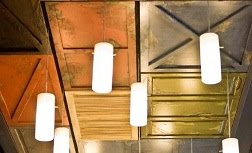Being in the industry and running a successful business I've had a lot of faux finishers ask how much to charge for doing finishes. The answer to this isn't a simple, short one or two sentence thing. First of all you have to answer a couple questions. One is: How much do I consider my skills to be worth? The fact is that it is different for everyone. It also varies by region of the country. A faux finisher in Los Angeles might be able to demand more or less than one in Wichita. It may also be based on your level of experience and the intrinsic value that you put on what you do. Maybe you offer finishes that are notnoffered by anyone else, or at least, anyone in your area. If that's the case then you could charge a premium. Then there's the economy part of it. In an up economy you might be able to get more than a down economy. As you've read before I'm not a chicken little type when it comes to down times and recessions and all. Another part of the equation comes from how much you have invested in the ENTIRE process. When I say investment you have to think about the time you put into it as well as the money you spend on your business and supplies to get the sale. So, now I'm going break it down for you. The following is a pretty good list of the line items and components involved in costing out your faux finish job.
-Regular business expenses a. Taxes (income, sales, local, etc.) - There might be several that apply b. Business licenses c. Marketing expenses - This would include your website, advertising, brochures, business cards, etc. d. Accounting expenses - Any costs you have associated with accounting software, bookkeeping, or using an accounting professional e. Supplies/Operations expenses - You do samples to show clients, buy brushes, rollers, sundries, etc. f. Miscellaneous expenses - There are other things that come up.
These would be specific to your business. Now that we have covered that we should now consider the entire order of things from getting a lead to finishing the project.
- Getting the lead You find prospective clients or they find you. This could be a referral from someone, answering an ad you've put out, finding you through a Google search, or another means. Sometimes there's a cost to this and sometimes the referral may come about at no cost. It is, however, something to consider in the equation.
- Meeting with the client for sales consults. In this case you could have several types of expenses. Gas and vehicle, samples to help get the business, etc. Then you have the time you spend with the prospect. Figure up how much that is (including all of the things you do with regards to selling them) and then multiply that time by the value you have placed on an our of your skills.
-Preparing for the job. Once you land the project then you have some more work to do. There could be more meetings with samples, you will have to order supplies and buy tools, and you will have to make sure your deposits and paperwork are squared away (time). There are obviously both hard costs and soft costs associated with this step. -Doing the job. Now that you've gotten the work you will have the expense of travelling to the job and the actual time it takes to complete it. You might also have to get more supplies and tools as you get into it.
-Post job. Even though the finishing is finished you still have some stuff to do afterwards. This could include going back to do touch ups, invoicing and collecting on the remainder of the project payment, follow up calls and thank yous, etc.
As you can see there are lots of moving parts when it comes to landing, completing, and tying up loose ends for a faux finish or cabinet refinishing job. For more information or questions feel free to email me at thefauxguy@gmail.com.
Thursday, June 18, 2009
Subscribe to:
Post Comments (Atom)




No comments:
Post a Comment